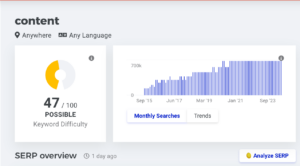How to Find Good Keyword Difficulty Scores for Blogs & Websites
Disclosure: This post contains affiliate links for which we may receive a commission when to click on the link and purchase. We appreciate your support.
Finding high search volume keywords is one of the important factors in ranking your content higher on the Google search engine and social media sites.
In particular, your blog posts or articles may appear first on the search queries when audiences search a specific topic or question related to your content keywords.
This is a part of on-page SEO, which requires bloggers and digital marketers to implement the ongoing keyword search strategy to increase the website’s online visibility and generate more leads.
The main challenge for many new sites with low authority scores is to find and balance both short and long-tail keywords ( with low difficulty) in their content and can compete with other competitors for ranking.
In this article, you will learn about keyword difficulty score and keyword search volume, and step by step guide to finding good keywords to use on your content for SEO optimization.
What is the keyword difficulty Score?
Table of Contents
Keyword difficulty indicates the level of competition of a particular keyword that can appear on search engines like Google or Bing. In particular, sites with high authority scores can use high-level keyword difficulty scores, ranging from 50- 70, while it’s impossible for new sites to rank on search engines if they use high-level competition keywords.
Typically, the keyword difficulty score scale is from 0-100. If you use the keyword difficulty score under 50, then there is a higher chance your content and website may rank well on the Google search.
There are a number of factors that have an impact on keyword difficulty and ranking as follows:
- Provide high-quality content.
- Your website SEO: on-page and off-page SEO.
- Domain authority.
As part of the keyword research strategy, the keyword difficulty and keyword search volume are the two important aspects you should take into account when finding both long and short-tail keywords for content optimization.
If you are a beginner, use popular keyword research and SEO tools like KWFinder or Scalenut ( AI writing & SEO tool ) to find the right keyword difficulty scores and include them on your site.
Based on my experience, only choose the low keyword competition score if you are a new site owner. After creating high-quality content, and increasing your site authority score, you can search for keywords with higher difficulty scores.
Related: How to Create Quality Content for Your Blog & Website
Is high keyword search volume good?
Generally speaking, choosing a high keyword search volume is good for your site’s search engine optimization. It’s because many people are searching for those keywords, and if you can target them in your content, then you can tap into many clients and traffic through organic search.
Depending on your website or blog authority scores, you can only the appropriate keyword with an average competition score to compete with other sites. In other words, the rule is to choose the high search volume keywords with low difficulty scores.
For example, if your site authority score is 2, then the only chance to rank higher on search engines and reach more organic traffic is to search for a high search volume keyword with authority scores ranging from 30-40.
In addition, high-authority websites always rank higher on search queries due to the fact that they have a large number of quality backlinks, quality content, and authority scores. For this, they can select the high search volume keyword with high competition scores.
Step by step to find a good keyword with a low difficulty score for SEO optimization
In this section, we will go through the step-by-step guide to conducting keyword research and finding a good keyword with a low difficulty score using the keyword difficulty checker, KWFinder.
If you are a new site owner or new to SEO, then don’t skip this section as it is really important to find the right keyword and build your site online visibility.
- Step one: sign up for KWFinder and create an account.

- Step two: enter keywords you want to target, choose location and language.

- Step three: highlight the high search volume keyword and its difficulty score.

- Step four: take the analysis to understand the monthly search for each targeted keyword and its search trends as well as current domains that use the same keywords.
In this case, you can avoid keywords with high difficulty scores (used by other high authority domains) and choose the appropriate one that fits your site content and authority score.
Final thoughts on Keyword search volume for SEO
Choosing the appropriate keyword search volume and keyword difficulty score are the two most important steps to optimize your content.
For this, depending on your site authority score, you can select the target short and long-tail keywords to include in your blog post or article and rank higher on search engines.
Keep in mind that you need to balance the keyword density in your content, not too high or too low as it may have a negative impact on your site’s SEO performance.
Additional reading resources related to digital marketing & blogging tips:
13 Best Blogging Tools for Bloggers and Site Owners: Pro Tips
The 6 Best AI Writing Tools for Freelance Writers & Bloggers
8 Best SEO Tools to Increase Website Traffic (Updated)
Don’t forget to share and Join us at Jns-millennial.com for more tips
